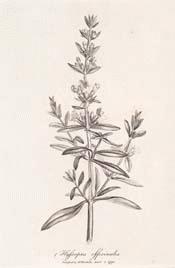
Botanical.com Home Page
Hyssop
Botanical: Hyssopus officinalis (LINN.)
Family: N.O. Labiatae
---Part Used---Herb.
Hyssop is a name of Greek origin. The Hyssopos of Dioscorides was named from azob (a holy herb), because it was used for cleaning sacred places. It is alluded to in the Scriptures: 'Purge me with Hyssop, and I shall be clean.'
---Cultivation---It is an evergreen, bushy herb, growing 1 to 2 feet high, with square stem, linear leaves and flowers in whorls, six- to fifteen-flowered. Is a native of Southern Europe not indigenous to Britain, though stated to be naturalized on the ruins of Beaulieu Abbey in the New Forest.
Hyssop is cultivated for the use of its flower-tops, which are steeped in water to make an infusion, which is sometimes employed as an expectorant. There are three varieties, known respectively by their blue, red and white flowers, which are in bloom from June to October, and are sometimes employed as edging plants. Grown with catmint, it makes a lovely border, backed with Lavender and Rosemary. As a kitchen herb, it is mostly used for broths and decoctions, occasionally for salad. For medicinal use the flower-tops should be cut in August.
It may be propagated by seeds, sown in April, or by dividing the plants in spring and autumn, or by cuttings, made in spring and inserted in a shady situation. Plants raised from seeds or cuttings, should, when large enough, be planted out about 1 foot apart each way, and kept watered till established. They succeed best in a warm aspect and in a light, rather dry soil. The plants require cutting in, occasionally, but do not need much further attention.
---Medicinal Action and Uses---Expectorant, diaphoretic, stimulant, pectoral, carminative. The healing virtues of the plant are due to a particular volatile oil, which is stimulative, carminative and sudorific. It admirably promotes expectoration, and in chronic catarrh its diaphoretic and stimulant properties combine to render it of especial value. It is usually given as a warm infusion, taken frequently and mixed with Horehound. Hyssop Tea is also a grateful drink, well adapted to improve the tone of a feeble stomach, being brewed with the green tops of the herb, which are sometimes boiled in soup to be given for asthma. In America, an infusion of the leaves is used externally for the relief of muscular rheumatism, and also for bruises and discoloured contusions, and the green herb, bruised and applied, will heal cuts promptly.
The infusion has an agreeable flavour and is used by herbalists in pulmonary diseases.
It was once much employed as a carminative in flatulence and hysterical complaints, but is now seldom employed.
A tea made with the fresh green tops, and drunk several times daily, is one of the oldfashioned country remedies for rheumatism that is still employed. Hyssop baths have also been recommended as part of the cure, but the quantity used would need to be considerable.
[Top]
---Preparation---Fluid extract, 30 to 60 drops. The Hyssop of commerce (Hyssopus officinalis) occurs in Palestine, but is not conspicuous among the numerous Labiatae of the Syrian hillsides, which include thyme and marjoram, mint, rosemary and lavender. Tradition identifies the Hyssop of Scripture with the familiar herb, Marjoram (origanum), of which six species are found in the Holy Land. The common kind, so well known in cottage gardens (O. vulgare), grows only in the north, but an allied species (O. maru) abounds through the central hills, and a variety is common in the southern desert.
Dr. J. F. Royle disagrees, and identifies the Hyssop of the Bible with the Caper-plant (Capparis spinosa) which grows in the Jordan Valley, in Egypt, and the Desert, in the gorges of Lebanon, and in the Kedron Valley. It 'springs out of the walls' of the old Temple area. This view is supported by Canon Tristram and others. The Arabs call it azaf.
The leaves, stems and flowers of H. officinalis possess a highly aromatic odour and yield by distillation an essential oil of exceedingly fine odour, much appreciated by perfumers, its value being even greater than Oil of Lavender. It is also much employed in the manufacture of liqueurs, forming an important constituent in Chartreuse. Bees feed freely on the plant and the odour of the honey obtained from this source is remarkably good. The leaves are used locally as a medicinal tea. As a kitchen herb it has gone out of use because of its strong flavour, but on account of its aroma it was formerly employed as a strewing herb.
RECIPE FOR HYSSOP TEA
'Infuse a quarter of an ounce of dried hyssop flowers in a pint of boiling water for ten minutes; sweeten with honey, and take a wineglassful three times a day, for debility of the chest. It is also considered a powerful vermifuge.' (Old Cookery Book.)
Common Name Index
A MODERN HERBAL Home Page
Bear in mind "A Modern Herbal" was written with the conventional wisdom of the early 1900's. This should be taken into account as some of the information may now be considered inaccurate, or not in accordance with modern medicine.
© Copyright Protected 1995-2025 Botanical.com
|


